#verb forms List With Hindi Meaning
Explore tagged Tumblr posts
Text
3000 Verb in Hindi | Kriya in English Grammar
3000 Verb in Hindi | Kriya in English Grammar Definition of Verb: A word that shows an action, state or an event is called a verb. जिस शब्द से किसी क्रिया, अवस्था या घटना का बोध हो, उसे क्रिया कहते हैं। Types of Verb Main Verb Heling Verb Transitive Verb Intrasitive Verb Primary Auxiliary Model Auxiliary 3000 Verb in Hindi Kriya in English Grammar List of Verb in Hindi and English Sr…

View On WordPress
#50 verbs in english#English grammar#forms of verb 1st 2nd and 3rd#irregular verbs english#list of common verbs#List of Verb in hindi#regular verb list#spoken English#three forms of verb chart#types of verb#verb#verb definition for class 6#verb forms List With Hindi Meaning#verb list#verb list in hindi#verbs forms list#verbs list#what is a verb for kids
0 notes
Text


Okay, so some sources and native speakers may disagree, but Wikipedia lists अं and the twelfth and अँ as the fourteenth letters and vowels of the Hindi script.
And it's true that these letters as such do not come up in Hindi words, but what's possible is to see many letters which may or may not be the letter अ written with the nasal vowel diacritic anusvār ं or chandrabindu ँ on top of it.
I've already made a post about how anusvār affects pronunciation - in short, it usually adds a nasal consonant into the word which is pronounced in the same place in the mouth as the following consonant:
अंदर [andar] - inside (adverb) नवंबर [navambar] - November (masculine) संकेत [saṅket] - signal, mark (masculine)
Chandrabindu on the other hand means that the vowel it's written above is pronounced as nasalised:
हँसना [hãsnā] - to laugh (intransitive) पहुँचना [pahũcnā] - to arrive (intransitive) मुँह [mũh] - mouth (masculine)
However, if there's already a mātrā on top of the letter, the moon crescent part of the chandrabindu gets left out, and it basically looks like an anusvār and the speaker sort of needs to know that it's implied.
It's quite easy with vowels at the end of the word (में, मैं) where there's no next consonant available for the nasal consonant to attach to, and with verbs that become nasalised in plural form - with a very basic knowledge of the grammar, it's easy enough to remember that both in हूँ and हैं the vowel becomes nasalised.
It becomes a bit more complicated with words like नींद [nīnd] or भैंस [bha͠is], where we just need to learn on a case by case basis which words have a nasal consonant adding anusvār, and which have a vowel nasalizing chandrabindu above the vowel mātrā. Again, listen to the native speakers to train your ear!
5 notes
·
View notes
Text
Uniqueness of Indian Languages
Uniqueness of Indian Languages No country in the world comes close to matching the linguistic diversity of India just the number of ‘mother tongues’ in the country. All Indian scripts come from the same script Brahmi, and Sanskrit have extremely strong oral traditions. All Indian languages fall into one of these 4 groups; Indo-Aryan, Dravidian, Sino-Tibetan and Afro-Asiatic. Hindi was known by different names at different stages of its evolution in different eras. It was known as Apabhramsa at its earliest stage. The official language of India is Hindi and 22 languages, which have been referred to as scheduled languages and given recognition, status and official encouragement.
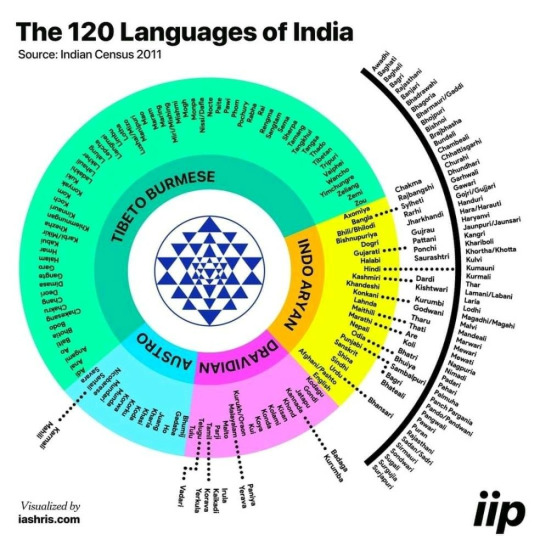
The Govt of India has awarded the distinction of classical language to Tamil, Sanskrit, Kannada, Telugu, Malayalam, and Odia due to their long history of 1500-2000 years. The 120 Languages of India with speakers of about 10000 sub; Hindi (mother language from Sanskrit) is so concocted language and has progressively subsumed many original languages by classifying them as 'dialects'. Language is an ever lasting emotion. It seems we feel much comfort when we communicate in our mother tongue (Native language). Indian languages have been in existence and use for many centuries, and are well established. Their uniqueness lies in their originality, authenticity in terms of structure/grammar, richness in content and meaning belongs to Sanskrit. Over 970 million people in the world speak Hindi. Bengali have about 250 million and Punjabi 120 million speakers respectively worldwide, ahead of popular languages like German and French, while the other top scheduled languages (Bengali, Marathi, Telugu, Tamil and Odia etc.) accounted for over a quarter of the population. Around 96.7% of the population listed one of the 22 scheduled languages as their mother tongue and 3.1% named one of the non-scheduled languages. The extinct and endangered languages of the Andaman islands form a fifth family. However, the mother tongues listed by 0.2% of the population were lumped under “Other Languages”. Kannada language has the second oldest written tradition of all vernacular languages of India. Indian Scripts are well developed and easy to learn with respect to Chinese or Russian or European non English languages. The Vedic Saṃskṛtam spread in India resulting in Punjabi (west), Hindi (center), Bengali (east), Gujarati (west), and Marathi (south). Sanskrit is supposed to belong to the same family as Latin. That is why there are many words ending in ‘um’ in both languages. NASA scientist Rick Briggs once said that Sanskrit is the only unambiguous language in existence. Sanskrit is the most technology advanced computer friendly language. Around 99% of Urdu verbs have their roots in Sanskrit. Brahui is a Dravidian language, with its roots in India.
Credit claimed by Dr. Anadi Sahoo
From Social Media - full credit goes to the respected unknown creator. Thank You.
1 note
·
View note
Text
How I Learn Languages
As an aspiring polyglot, it’s important that I have a bunch of resources at my disposal for language learning. I use a variety of resources for my learning, such as books, websites, apps, T.V. shows, movies, etc. These are some of my resources!
-Websites-
1. Omniglot
This website is more for finding information about languages and finding languages to learn. It has a very comprehensive list of languages and you can find plenty of secondary resources for learning the language. You can find tutors for that language, and even songs in your target language. I can just about guarantee you that no matter what language you’re looking for, it will be documented here. It is absolutely amazing, and it is a FANTASTIC resource for the dedicated linguist.
http://www.omniglot.com/
2. Duolingo
This is both a website AND an app, however, I tend to use the website more frequently, mainly because I’m always on my laptop anyway. The learning system that this website uses makes out very easy to stay motivated, and the lessons are organized amazingly. Currently, the website offers about 27 different language courses for English speakers, and various language courses for speakers of languages other than English. You can set goals for yourself, take multiple courses, be involved in discussions, and even do translating activities. Beware though, it gets VERY addicting.
https://www.duolingo.com

3. Memrise
Also a website AND an app, this is my all time favorite resource for learning languages. It has SO many languages to choose from, and it even offers subjects other than languages, although foreign language learning is its primary appeal factor.
http://www.memrise.com/home/

4. BBC Languages
Although this sector of BBC has been archived and is no longer updated, it still contains some valuable information. It includes some useful phrases, alphabet guides, and jokes in many languages. You’re bound to learn something new there, so check it out!
http://www.bbc.co.uk/languages/
5. Foreign Service Institute (FSI)
This website offers language courses constructed by the U.S. government, and relies heavily on audio-based learning. However, many of the language courses include lessons in the form of pdf. There is a very large selection of languages to choose from, so this resource is very good for getting an excellent introduction to your target language.
https://fsi-languages.yojik.eu/
6. Live Lingua Project
Claiming to be the internet’s largest collection of free public domain language learning materials, this website is a MUST for language learners. It contains the FSI courses, Peace Corps language learning materials, and the DLI (military) language courses. It also offers Skype sessions for language learners in several different languages! The main appeal of this website, however, is the Peace Corps language material archive. There are SO many different languages to choose from, and there are many ebooks and audio files to take advantage of here.
https://www.livelingua.com/#project
7. Languages On the Web
This website offers texts that translate English texts into 55 other languages. It is not a translator, it merely provides reading material in foreign languages to learners. It is a very useful website, especially for analyzing how sentences are formed in other languages.
http://www.lonweb.org/
8. Learn 101
This website is really helpful for explaining grammatical concepts and for learning general stuff about languages, such as verbs, vocabulary, nouns, adjectives, basic phrases, foods, etc. There are quite alot of languages offered on this website, so it’s a great resource!
http://learn101.org/
9. Clozemaster
This website is great for learning languages through a sentence based, contextual experience. It’s a bit like Duolingo in that sense, and it requires you to fill in missing words from sentences. In my opinion, it’s better for people with a background in their target language, and they offer many different options for languages. It’s also good for speakers of a native language other than English!
https://www.clozemaster.com/

10. Lexicity
This is a great website for ancient language learners, and it provides resources for Egyptian, Mayan, Hittite, Latin, Old English, Etruscan, Gaulish, and several others. I have found the majority of resources that I have looked through helpful to my learning efforts. They have dictionaries, grammars, charts, and texts, and it is a very comprehensive resource.
http://lexicity.com/

11. Book2
This is a good resource for learners looking for audio files to help them practice their listening. I haven’t used it all too much, but there are many language options, so you’re bound to find a language that you find interesting on here.
http://www.goethe-verlag.com/book2/
12. Lang-8
This is a great resource for getting feedback on your writing in your target language. You can post things in your target language, and native speakers of that language will correct it, and you can do the same for other people! It’s very helpful, and is a great resource if you have to write in your target language often.
http://lang-8.com/

13. Bilinguis
This website offers a few books to read in different languages and is good for comparing different languages of the same book. This makes for good practice for reading in your target language.
http://bilinguis.com/
14. Udemy
There are quite a few languages courses on this website, although several of them cost money. However, there are quite a few courses that are free, and are good for introducing you to your language of choice.
https://www.udemy.com/courses/
-Apps-
1. Memrise
As mentioned above in the websites section, this app is so amazing for on-the-go language learning, as well as for subjects other than languages! It helps users memorize concepts with “meme” which are pictures that will remind you of what the word or concept means, and it’s such a unique and fun learning experience! It has the feel of using flashcards, but I just love using this app so much.
2. Duolingo
Also mentioned in the websites section, this app is great for both learning new words and reviewing words that you have either memorized or have just been exposed to. There are grammar lessons available, translation activities, groups that you can join, and Duolingo makes it fun to learn a language with it’s reward system.
3. HelloTalk
This is my absolute FAVORITE app to talk to native speakers of my target language(s). You can become language partners with people, help others with translations, video/voice call, send voice messages, and have as many partners as you want! It’s an absolutely amazing app, and I highly recommend it to everyone! Warning- If you’re a native English speaker looking for a native Chinese speaker, you will get HUNDREDS of requests. It might overwhelm you for a second.

4. TuneIn Radio
This is really great for finding stations in your target language, and it helps with practicing both comprehension of spoken language as well as introduces you to awesome music in your target language!
5. Tigercards
This app presents words in the form of lists, and gives you vocab so that you can review it. Not the best presentation of words and it doesn’t really offer a memorization technique like Memrise, but it’s still helpful!
6. Busuu
This app is a bit like Duolingo, and it offers German, Spanish, Portuguese, French, English, Italian, Russian, Polish, Turkish, Japanese, and Chinese!
7. uTalk
This app offers so many different languages, it’s pretty incredible. There are games that you can play, phrasebooks, and several other features. The interface is also really awesome and simple, so it makes learning easier than usual. Definitely a must have.

8. Innovative Language
I haven’t used this app much, but I have heard that the lessons on this app are very good, and you can download the lessons so that you can view them offline.
9. FlashSticks
This has been super helpful to me, in addition to the games and flashcards that it offers, it also provides an object scanner, which uses your camera to scan objects and then tells you what it’s called in your target language!

10. Mondly
This has been an awesome resource for me since it’s a bit like Duolingo, only with more unique language options. I’m currently using it to learn Hindi, however, there are tons of other language options. The interface is awesome, and I love using it.

11. MindSnacks
This company makes several different language apps, and currently I’m using the Mandarin, Japanese, and French ones. So far, I’ve really enjoyed these apps!
12. Spotify
Through Spotify’s “Word” category, there are many different playlists dedicated to language learning, such as for Arabic, Mandarin, French, Spanish, German, Italian, Russian, Portuguese, and Swedish!
13. Quizlet
This is more of a diy language learning resource. It is not an inherent language learning resource, however, if you learn best through lists and/or flashcards, then this app allows you to make cards and review vocab that way! I use it all the time for exams!
14. FluentU
This is an awesome app for watching videos in your target language, and is really good for learning new words.
-Books-
1. Teach Yourself
This series offers an astounding number of languages, and I have found them to be pretty effective in helping me learn languages. I have used the Russian, Arabic, Mandarin, and Irish ones.
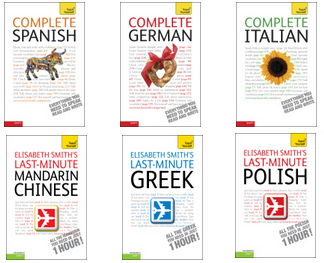
2. Barron’s Grammar and Verb books
I really like the way Barron’s does language books, so far I have used their Japanese grammar book and their Russian verbs book, and I really like the layout of them, especially the grammar book!
3. Dk Visual Bilingual Dictionaries
These are so helpful for me, I’ve been using the Mandarin and Japanese dictionaries for a long time, and they are so comprehensive and awesome!
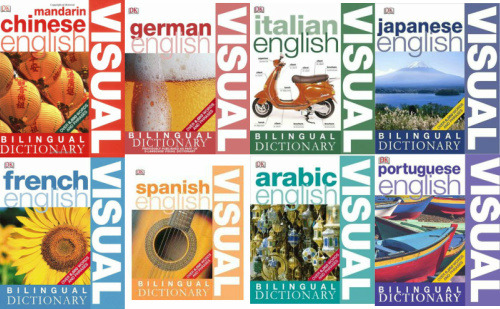
4. Ethnologue
These aren’t language “learning” materials, but rather they help me find new languages to learn. These are more for the linguistic lovers, since they catalog almost every living language in the world in every country, and provide language maps and statistics. There’s really fascinating stuff in those books, so I highly recommend purchasing them.
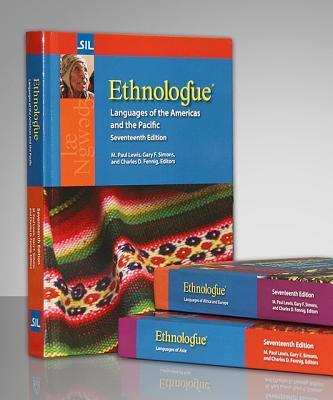
5. The “Dirty” books
So far, I have only used the Japanese version, however, I really like what the book includes, and it’s great for learning slang in your target language, and things that traditional textbooks wouldn’t teach you.
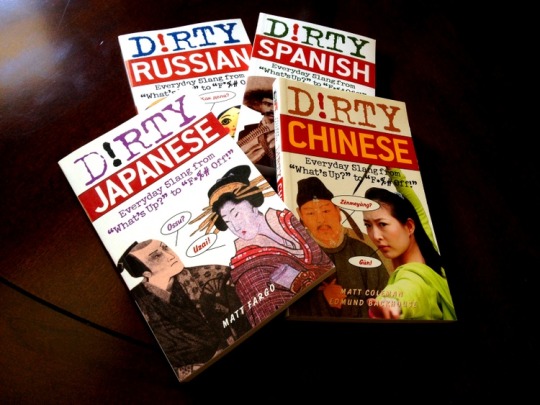
6. Living Language
I LOVE these books so much, I’ve used the Russian, Mandarin, and French ones and I’ve found them very helpful! The layout of these are very nice, and they’re pretty comprehensive.
7. Tuttle books
Tuttle offers several different language books, and they all are very good in my opinion. I have used their books for Arabic, Korean, Mandarin, Japanese, and Hindi.
That’s all that I have right now, but if you all would like more resources than I will definitely make a second one!
133 notes
·
View notes
Text
Hindi Grammar
Learn Hindi Grammar in 30 days with us. We Provide and Learn Hindi Basicsis a unique method, and probably the only one online web of Hindi grammarin which the important questions for the exam based on the critical points have been compiled extremely conveniently and in an easy manner.
‘Hindi Grammar or Hindi Vyakaran’ What is the different?
Vyakaran (Vyakaran) meaning in English (इंग्लिश मे मीनिंग) is GRAMMAR(Vyakaran ka matlab english me GRAMMAR hai). Get meaning and translation of Vyakaran in English language with grammar, synonyms and antonyms. Know the answer of question : what is meaning of Vyakaran in English dictionary? Vyakaran (Vyakaran) ka matalab Angrezi me kya hai ( Vyakaran का अंग्रेजी में मतलब, इंग्लिश में अर्थ जाने).
Vyakaran Meaning In English
व्याकरण {vyakaraN} = GRAMMAR(Noun)
व्याकरणिक {vyakaraNik} = GRAMMATICAL(Adjective) — Usage : the grammatic structure of a sentence
व्याकरण भाषा {vyakaraN bhaSha} = GRAMMAR(Noun)
व्याकरण सम्मत {vyakaraN sammat} = GRAMMATICAL(Adjective)
व्याकरण सम्मत {vyakaraN sammat} = WELL FORMED(Noun)
व्याकरण संबंधी {vyakaraN sanabanadhi} = GRAMMATICAL(Adjective)
व्याकरण पाठशाला {vyakaraN paThashala} = GRAMMAR SCHOOL(Noun
व्याकरणिक स्थान {vyakaraNik sthan} = SLOT(Noun) — Usage : he developed a version of slot grammar
व्याकरण विरुद्ध {vyakaraN viruddh} = UNGRAMMATICALLY(Adverb) — Usage : He writes ungrammatically.
व्याकरण की पुस्तक {vyakaraN ki pustak} = GRAMMAR(Noun)
व्याकरण सम्मत ढंग से {vyakaraN sammat Dhanag se} = GRAMMATICALLY(Adverb) — Usage : this child already speaks grammatically
व्याकरणिक क्रिया कर्तृवाच्य/कर्मवाच्य/भाववाच्य {vyakaraNik kriya kartaRavachy/karmavachy/bhavavachy } = VOICE(Noun)
Learn Rules Of Hindi Grammar
Learn Hindi Grammar With this website. All the the topic listed below are described in easy to learn Hindi Grammar way for education. In each lesson you will find an explanation of the grammatical rules.
Hindi Grammar — Easy or Difficult
English meaning of Vyakaran , Vyakaran meaning in english, Vyakaran translation and definition in English.
English meaning of Vyakaran , Vyakaran meaning in english, Vyakaran translation and definition in English language. Vyakaran का मतलब (मीनिंग) अंग्रेजी (इंग्लिश) में जाने.
Learn All Hindi Grammar
Those topic you want to learn in hindi vyakaran go on there and read and learn something new.
Hindi Vyakaran
Hindi Vyakaran (हिंदी व्याकरण), Hindi Grammar Lessons in detail. Learn HindiGrammar online. Prepare all Hindi Grammar topics for your next exam.
समास — परिभाषा, भेद और उदाहरण : हिन्दी व्याकरण, Samas In Hindi | Hindi Vyakaran
छन्द — परिभाषा, भेद और उदाहरण : हिन्दी व्याकरण, Chhand in Hindi | Hindi Vyakaran
Alankar (अलंकार) — परिभाषा, भेद और उदाहरण : हिन्दी व्याकरण, alankar in hindi
हिन्दी की प्रमुख रचनाएँ और कवि : हिन्दी व्याकरण | Hindi Vyakaran
लोकोक्तियाँ — Lokokti, Proverbs in Hindi : हिन्दी व्याकरण
वर्तनी: शब्द एवं वाक्य शुद्धीकरण : हिन्दी व्याकरण ( Shudh Ashudh Shabd Evam Vakya) | Hindi Vyakaran
वात्सल्य रस (Vatsalya Ras) — परिभाषा, भेद और उदाहरण : हिन्दी व्याकरण
Muhavare — मुहावरे, Idioms in Hindi : हिन्दी व्याकरण
हास्य रस (Hasya Ras) — परिभाषा, भेद और उदाहरण : हिन्दी व्याकरण
वीर रस (Veer Ras) — परिभाषा, भेद और उदाहरण : हिन्दी व्याकरण
भक्ति रस (Bhakti Ras) — परिभाषा, भेद और उदाहरण : हिन्दी व्याकरण
रस के प्रकार, रस का स्थायी भाव : रस और भाव | Hindi Vyakaran
Hindi Grammar / Hindi Vyakaran
करुण रस (Karun Ras) — परिभाषा, भेद और उदाहरण : हिन्दी व्याकरण | Hindi Vyakaran
वीभत्स रस — Vibhats Ras — परिभाषा, भेद और उदाहरण : हिन्दी व्याकरण
भयानक रस — bhayanak ras परिभाषा, भेद और उदाहरण : हिन्दी व्याकरण
शांत रस — shant ras — परिभाषा, भेद और उदाहरण : हिन्दी व्याकरण
श्रृंगार रस (Shringar Ras) — परिभाषा, भेद और उदाहरण : हिन्दी व्याकरण
रौद्र रस (Raudra Ras) — परिभाषा, भेद और उदाहरण : हिन्दी व्याकरण
अद्भुत रस — adbhut ras — परिभाषा, भेद और उदाहरण : हिन्दी व्याकरण
रस — परिभाषा, भेद और उदाहरण : हिन्दी व्याकरण, Ras In Hindi Vyakaran
Ekarthak Shabd, एकार्थक शब्द, Ekarthi Shabd in Hindi : हिन्दी व्याकरण
Anekarthi Shabd, अनेकार्थी शब्द, Anekarthak Shabd in Hindi : हिन्दी व्याकरण
युग्म-शब्द — Samanarthi Shabd (Combination words), समोच्चरित भ���न्नार्थक शब्द, Shabd Yugm | Hindi Vyakaran
Tatsam Tadbhav ( तत्सम तद्भव ) शब्द, परिभाषा, पहचानने के नियम और उदाहरण : हिन्दी व्याकरण | Hindi Vyakaran
संबंधबोधक अव्यय (sambandhbodhak avyay) — परिभाषा, भेद और उदाहरण : Preposition of Hindi
निपात-अवधारक (Nipat-Avdharak) — परिभाषा, भेद और उदाहरण : हिन्दी व्याकरण
अव्यय — परिभाषा, भेद और उदाहरण : हिन्दी व्याकरण, Avyay in Hindi | Hindi Vyakaran
PARYAYVACHI SHABD — पर्यायवाची शब्द — परिभाषा, उदाहरण : हिन्दी व्याकरण
विराम चिन्ह (Punctuation Mark) — परिभाषा, भेद (प्रकार) और उनका प्रयोग : हिन्दी व्याकरण | Hindi Vyakaran
Vilom Shabd in Hindi (Antonyms) विलोम शब्द / विपरीतार्थक शब्द : हिन्दी व्याकरण | Hindi Vyakaran
अनेक शब्दों के लिए एक शब्द ( one word substitution ) : हिंदी व्याकरण | Hindi Vyakaran
संधि — विच्छेद, परिभाषा, भेद और उदाहरण : हिन्दी व्याकरण, sandhi in hindi
प्रत्यय — परिभाषा, भेद और उदाहरण : हिन्दी व्याकरण, Pratyay in Hindi
उपसर्ग — परिभाषा, भेद और उदाहरण : हिन्दी व्याकरण, Upsarg in hindi
पुरुष — परिभाषा, भेद एवं उदाहरण : हिन्दी व्याकरण, Purush in hindi !
वचन — परिभाषा, भेद और उदाहरण : हिन्दी व्याकरण, Vachan in Hindi | Hindi Vyakaran
लिंग — परिभाषा, भेद और उदाहरण : हिन्दी व्याकरण, Gender in Hindi | Hindi Vyakaran
कारक — परिभाषा, भेद और उदाहरण : हिन्दी व्याकरण, Karak in Hindi | Hindi Vyakaran
वचन — परिभाषा, भेद और उदाहरण : हिन्दी व्याकरण, Noun and Number in Hindi Grammar
विस्मयादिबोधक — परिभाषा, भेद और उदाहरण- हिन्दी व्याकरण, Interjection in hindi
क्रियाविशेषण — परिभाषा, भेद और उदाहरण : हिन्दी व्याकरण | Hindi Vyakaran
समुच्चय बोधक — परिभाषा भेद और उदाहरण : हिन्दी व्याकरण, Conjuction In hindi
विशेषण — परिभाषा, भेद और उदाहरण : हिन्दी व्याकरण, Visheshan in Hindi
क्रिया — परिभाषा, भेद, और उदाहरण : हिन्दी व्याकरण ( Verb in hindi )
भाषा — परिभाषा, ��ाज्यभाषा, राष्ट्रभाषा और राजभाषा : हिन्दी व्याकरण
वाक्य — वाक्य की परिभाषा, भेद और उदाहरण : हिन्दी व्याकरण
सर्वनाम — परिभाषा, भेद और उदाहरण : हिन्दी व्याकरण, Pronoun in Hindi
पद (Pad Parichay) — Phrases — पद क्या होता है ? | Hindi Vyakaran
संज्ञा — sangya in hindi- परिभाषा, भेद और उदाहरण : हिन्दी व्याकरण, Noun in hindi
वर्ण विभाग — वर्णमाला की परिभाषा एवं उनके भेद : हिन्दी व्याकरण | Hindi Vyakaran
शब्द (Shabd) (शब्द-विचार) — परिभाषा, भेद और उदाहरण : हिन्दी व्याकरण | Hindi Vyakaran
2 notes
·
View notes
Text
CELTIC-ISRAELITE COMMONALITIES
http://www.british-israel.ca/Celtic.htm
by Yaacov Levi
To many who are interested in the history of the Celtic peoples and their modern descendants in Ireland, Wales, Scotland, Brittany and Cornwall, and from their descendants around the world a subject that is often brought up is possible connections with the ancient Israelites, in particular the “Lost Tribes” of Israel.
The purpose of this article is not to establish ‘connections’ to the Lost Tribes, but to discuss some of the many common characteristics of these modern Celtic peoples and the ancient Israelites. These characteristics I call Commonalities. I am not attempting in this short article to establish connections which has been addressed in many other volumes such as The Tribes and Ephraim by Yair Davidy and The Lost Tribes of Israel - Found! by Steven Collins as well as in ancient works. I am simply going to point out and discuss a very few of the great many commonalities between these peoples.
The Lost Tribes of The House of Israel
The peoples we refer to as the Lost Tribes were part of the Northern Kingdom of Israel which was conquered by the Assyrians around 740-720 BC. and exiled to areas in Assyria and to the north. This is told in the the Bible in 2Kings chapters 17 and 18. About the same time a contingent from the Kingdom of Judah were also exiled to the northern lands. It is these peoples and their immediate descendants that are also variously referred to as the Lost Tribes, and the subject of many works and studies.
Being both Irish and Jewish, I grew up familiar with customs and the cultures of both peoples, only in later years becoming aware that they were quite difference cultures and had greatly varying cultural characteristics. Yet growing up with both cultures, I had noticed similarities even on a casual basis. Over the years I began to see more of this similarity and in recent years I began to collect this data into what I term an Overview which I am still assembling. It is this Overview in differing areas of life that I will discuss here.
There are a number of areas that I have been looking at which includes: language, agriculture, religion and taboos, burial practices, music and folk dancing, the traditions and self determinations and self-identification of the Celts and other areas as the arise. I will point out a few items in each category and note that these are just a few of a great many commonalities and I mention them as examples.
Language is one of the subjects that led to my overall interest in the topic as early on I had noticed similarities. Considering the long period of time from the expulsion of the Israelites to our time, it would seem unlikely that there would be little, if any, common letters, words or structure, but that is not the case - there is indeed much in common.
Gaelic is a member of the Celtic group of the Indo-European family of languages that includes Russian, English, German, Spanish, French, Hindi and Italian. The Celtic group has been confined to the British Isles and part of the French coast.
Linguistic Similarities
The Celtic group is divided into two divisions which has three languages in each division. Each division makes up its own unique language.The two branches are:
the BRYTHONIC branch which is made up of the Welsh, Breton and Cornish lan guages; and
the GOIDELIC branch with the Irish, Scots and Manx Gaelic languages.
The Breton and Cornish languages are seeing some resurgence after near extinction while the Irish, Scots and Welsh languages are holding their own at this time. Manx is an ancient form of Irish and is considered to be oldest and purest Irish Gaelic in existence. Manx is very close to the extinct dialects of nearby Ulster and Galloway and separated from Old Irish in about the fifth century of our era. It occupies much the same position to Old Irish as Icelandic does to Old Norse. For the purpose of my study I have chose to concentrate on Manx and Scots Gaelic. I am sure though that an indepth study of Welsh or the other Gaelic languages would provide much food for thought on this issue.
The Gaelic alphabet as well as the ordinal numbers show more commonality than could be expected after 2,700 years of divergence; for example we have a Hebrew “S” retained in the modern Gaelic - the Hebrew Sheen, pronounced Shh is found in the Irish “S” as in the name Sean pronounced Shawn. Other letters are similar, the ordinal numbers 6 & 7 are pronounced almost the same as Hebrew and Gaelic. Words with same or similar meanings abound; for instance the Hebrew word for holy in common usage according to Halacha (Jewish law) is Kasher. The word in Manx Gaelic for hallowed or holy is Casherick. The syntax of Gaelic is entirely different from any other European language, especially English. RL Thompson, in his work Outline of Manx Literature and Language says that “in several respects Gaelic syntax has similarities with that of languages like Hebrew and Arabic”.
As in Hebrew, adjectives follow the noun that they describe: for example “ben vie” = “a good woman” in Gaelic and “Rosh ketan” = “small head” or “stupid” in Hebrew. Vie of ketan being the adjectives. The word order also is similar in Hebrew in that the verb is usually first in the sentence unlike English or many other European languages. These are just a very few of the many commonalities that I believe suggest a definite connection between the two languages and their family streams. This alone could constitute a major comparative study.
Commonalities in Ethnic Customs
One of the first areas in which I noticed similarities was in customs, notably folk dancing and later, musical instruments. The Hebrew Hora and other old traditional dances are parallelled in many Gaelic folk dances and especially the wedding dance of the Gaels which is very similar to the traditional Ashkenazic wedding dances of Europe. The musical instruments of the Gaels are
found in the Israelite tradition, notably the harp in both Celtic tales and certainly Hebrew tradition as the favoured instrument of the psalmist David [see the article “The Harp of David and the Harp of Ireland” by John Wheeler in the August-October issue of Origins of Nations - ed]. But, one of the most intriguing things to come up was that the Irish and Scots pipes we are all familiar with has its origins in the desert flute played daily throughout the Middle East. The flute of the desert shepherds is identifiable in the “chanter” of the Irish and Scots pipes.
Amazing Religious Parallels
The ancient religion of the Celtic peoples prior to Christianity was generally believed to be Druidism, of which we know very little; yet that which we do know has many overtones of the Canaanite religions that the northern tribes turned to after the split of King Solomon’s Kingdom under his son into a Northern and a Southern Kingdom. Like the pagans of Canaan, their sacred places became high hilltops and sacred groves, notably oaks. There is a great deal of similarities from what we know archaeologically in both the Northern Kingdom ritual sites and the Druid sites in the Isles. Additionally, the burial practices of both the peoples of the northern Kingdom and the Celts bear much similarity in the presence of Dolmens - large slabs of stone place horizontally across upright stones with the graves under them. These are found throughout the area of Europe which Celtic peoples passed and are found also in the areas of present day Jordan and Israel in which the Northern Israelite tribes dwelled.
You can find pictures of these dolmens in Yair Davidy’s book Ephraim on pages 137-38. This book is available from History Research Projects. Overseas it may be purchased direct from Yair Davidy in Israel (addresses on inside back cover).
Even Agricultural Similarities!
Agriculturally there are interesting commonalities - the grain crops are much the same, and even though wheat was known to them in their passage through Europe it was not a major crop in their final homes. In fact oats and barley were their staple grains. As with the Israelites, the cattle were of several colours, but the preferred colour for ritual for both peoples was red. The virgin cow used in the Hebrew ritual for purification was the forerunner of the red cattle used by the Druids in their rituals.
After the invasion of the Romans into the Isles, white cattle were introduced and later used; until that time red was the preferred colour. One of the most famous wars in Irish history was over a Red Bull stolen by a northern Irish tribe. Also, swine were not raised in any of the early Celtic areas until after they were introduced by the Romans; the Celts had a taboo against them, along with scaleless fish as eels and shellfish. The Celts, in similitude to the Israelites, were excellent headsman and developed identifiable breeds of sheep, cattle and horses, that carried on the traditions of the Israelites.
Other Proofs
Perhaps one of the most telling of the commonalities is simply the self-identification as Israelites - the Hibernians - the name of the Irish and the Scots and the Hebrides Islands off the coast of Scotland. The Milesians, one of the early Celtic peoples to come to Ireland from Spain had a tradition that they were of the Lost Tribes. The name Heber, Eber, or H’berian is found throughout early literature to describe the Celts as they described themselves to be “Of Eber” - the grandfather of Abraham.
What I have presented here in greatly abbreviated form just skims the surface of the commonalities between the Celtic Peoples and the Israelites. There is a tremendous amount of information available for those who would like to look at this closer themselves. A few resources are listed at the end. This is one of those subjects in which at first one can say “oh - that's an interesting coincidence”. But the sheer mass of these “coincidences” that build up after one goes from discipline to another becomes totally overwhelming. The fact that so much of the languages are similar almost three thousand years later, that customs are clearly identifiable as being related, that religious practices are uniquely similar and that the everyday agricultural practices and crops were similar - all along with the many other commonalities bespeak a common origin.
For those interested in pursuing this I wish you well and much enjoyment.
Suggested Information Sources
Manx Gaelic Society
Yn Cheshaght Ghailckagh
St Judes
Isle of Man IM7 2EW
United Kingdom
Gaelic Books Council
Dept of Celtic
University of Glasgow
Glasgow G12 8QQ
Scotland
Yair Davidy
Brit-Am
PO Box 595
Jerusalem
Israel 91004
Chadwick, N (1965) Celtic Britain. London.
Chadwick, N (1970) The Celts. United Kingdom.
Rankin, H (1987) Celts and the Classical World. London.
Squire, C (1905) Celtic Myth and Legend, Poetry and Romance. London.
Squire, C (1909) The Mythology of Ancient Britain and Ireland. London.
1 note
·
View note
Text
The preposition With Hindi Meaning
हेलो दोस्तों स्वागत हे ,आपका आज के इस very useful पोस्ट Preposition in Hindi meaning में आज हम preposition को उसके हिंदी मीनिंग तथा सभी most common Preposition को हिंदी -अंग्रेजी उदाहरणों के साथ पढ़ेंगे तथा समझने की कोशिश करेंगे।
Let 's start
A preposition is a word that indicates the relationship between a noun and the other words of a sentence.
Definition:-वे शब्द या शब्दों के समूह जो किसी संज्ञा या सर्वनाम और वाक्य के दूसरे भाग के बीच के सम्बन्ध को दर्शाते हैं, Prepositions कहलाते हैं। आमतौर पर इन्हें किसी संज्ञा या सर्वनाम से पहले स्थित किया जाता है। एक बात और, जिस संज्ञा या सर्वनाम के साथ Preposition का प्रयोग किया जाता है, वह संज्ञा या सर्वनाम इसका Object कहलाता है।
Prepositions are the words or the group of words, which are generally placed before a noun or a pronoun to express its relation with other part of the sentence. The noun or pronoun used with the preposition is called its object.
you can also read
List of An adjective
forms of the verb
list of collective noun
Preposition in Hindi meaning
The preposition With Hindi
English Hindi Use in a sentences
about के बारे में He is talking about me. वह मेरे बारे में बात कर रही हे।
above ऊपर Money is above love. पैसा प्यार से ऊपर है।
across पार My shop is across the road. मेरी दुकान रोड के उस पार है।
after के बाद April comes after the march.अप्रेल मार्च के बाद आता है।
against के विरोध One should not go against the rule. किसी को भी नियमो के विरुद्ध नहीं जाना चाहिए।
Read more
0 notes
Text
Is Hindi really that Hard to learn? How Can You Learn Hindi?
Hindi is one of the most common languages in the world with about 50 Crore native speakers. Bollywood, which mostly deals with Hindi movies, is also one of the largest film industries on the earth and comes after Hollywood's at the second most popular film industry. In recent years, many of the world's top actors in Bollywood have transited to Hollywood and narrowed the cultural gap between English and Hindi movies.
They were introduced more to Hindi through pop culture, films and music than they know. These may be some of the reasons for the deep insight into Hindi and you might be surprised by the depth of the language. So is it difficult to learn Hindi for native English speakers? And if so, what could you do?
Want to learn from a 20 years experienced tutor? Click Hindi Language Home Tutor!

How hard is Hindi?
Some foreign experts say that Hindi is one of the ten hardest languages in the world to learn, and there are several reasons behind this according to them. One of Hindi's most disheartening features is definitely the script, which is close to the Arabic form of writing, which is hardly understandable than even by Chinese characters, most claims. Hindi pronunciation can be challenging for native English speakers as it needs for a more flexible vocabulary and many variations in words are so slight that it is so simple for a new student to keep his foot in the mouth and say the wrong thing!
Moreover, the fact that Hindi is an SOV (Subject, Object and Verb) language in comparison to English’s SVO way of talking. It can take a lot of time for getting used to learning to speak: ‘I the ball picked up’ as opposed to ‘I picked up the ball’.
Is it not possible to learn?
The answer to this question is very simple: definitely not! There is no language in this world which cannot be learned by humans. Whether or not you can able to talk, it depends heavily on your commitment to learning. I noticed that one of the great things about Hindi is that many English words have already been embedded in the language. In modern India, the middle class usually speaks Hindi but includes a bit of English into a lot of discussions.
What's amazing is that when you're trying to learn Hindi, learning is a much simpler task. You can understand what people are saying, or at least the meaning, if you build a strong word list of Hindi terms from learners, by using what you learn and listening to the English words that you use. Obviously, you may not have such an easy time while talking, but, like with any word, as you practice, the better the process becomes.
How can you learn Hindi?
No tricks or shortcuts are required to learn Hindi. It takes you quite a while to get to the complicated pronunciation and to understand the sometimes unusual word order and vocabulary. However, you are fortunate because Hindi has resources almost everywhere in the world, almost more so than other languages: I'm talking about native Indians! Indians like to travel and particularly like to share their culture wherever they go.
There is an ongoing joke among the Indians that you cannot visit a city in the world until you meet some of your fellow citizens. You can find Indian restaurants almost everywhere around the world. While this might not be entirely true, there is a high probability that there will be Hindi natives in your area. So that's what you should benefit from! Many people like to encourage others to know their mother tongue and, even better, you’ll have somebody to watch and discuss Bollywood movies with!
Although Hindi is not going to be an easy language to learn, it is definitely an adventure to learn the skills to speak the Hindi language. If you want to learn Hindi them Dr Ramesh Mishra a very famous and experienced Hindi Home Tutors In Delhi will surely help you. It will open your eyes to a variety of rich culture that takes a lifetime to explore. I am sure you, as I am, will fall in love and be happy to always know more about the glorious Indian culture and one of the great languages called “Hindi”!
Have you got tips to help English speakers to learn Hindi? Share them with us!
For more details about learning Hindi, visit: http://hindisanskrittutor.in/ or you can directly call us @9810766253.
#Hindi Tutor in Delhi#Hindi Home Tutor#Hindi Teacher#Hindi Home Tutors In Delhi#Hindi Language Home Tutor
0 notes
Text
Top Dead and Constructed Languages to Learn

Top Dead and Constructed Languages to Learn - Sciforce - Medium
As a rule, when we choose a language to learn, we have several reasons in mind: they might be useful for our professional growth or helpful in travels or in communication with certain communities. We might need a language because we move to another country or because we fall in love with a foreigner. However, a new language can be not only a means of communication: it is also a way to sharpen your mind, to find a deeper mental structure in what might first seem to be verbal chaos — and ultimately it can become a proxy to mastering computer logic and machine learning.
That is why it is a good idea to learn not a real live language — but a tongue that is dead and reconstructed or completely invented. Striped of numerous exceptions, variations and usage simplification that are inherent to natural languages we speak, they show only the ideal logical structure in the core of any language — be it human, computer, or mathematical.
In this blog post, we’ll present a list of our top of dead and artificial languages that might be useful to learn.
Dead Languages

Latin
Much more than a dead language of a dead ancient Empire, Latin is the language that had an enormous impact on the development of other European languages, as well as on the European culture and science.
Why to learn?
Latin is the parent of the modern Romance languages, which include Spanish, French, Italian, Portuguese and others. Therefore, the knowledge of Latin can facilitate learning these languages — and train you to see and to use the connections and similarities between them. These connections are so huge that learning Latin will virtually open up access to the whole Romance language family — and boost your analytical skills.
Latin is a highly-inflected language, which means that you can alter the meanings of words by merely changing the ending suffice. On the one hand, it makes Latin difficult to learn; on the other hand, it gives you an idea of the power of minute changes and a good eye for detail. And you’ll see that Latin IS well-structured!
Latin is not so dead as we might think. It is used, of course, in Catholic Church, but, more importantly, it is the basis of medical and biological classifications and to a certain extent of the academic slang.
Where to learn?
Latin might be offered to you at your university (it might be also a compulsory course), so grab the chance!
There are of course numerous courses and learning resources for any level:
Getting started on classical Latin is a free course that is aimed not at mastering the language itself but rather at discovering Latin grammar structures and its impact on English.
Learn Latin is a free app that provides users with vocabulary (verbs, nouns, adjectives, adverbs) that they can easily use to learn a word a day. Example sentences will also be provided to help learn the new word.
New Latin Grammar — a textbook for those who like explicit explanations.

unsplash.com
Sanskrit
Similar to Latin in Europe, Sanskrit was the lingua franca of the Indian subcontinent for three millennia and it provided the foundational texts for Hinduism, Buddhism, Sikhism and Jainism.
Why to learn?
Sanskrit has a huge impact on modern Indo-Aryan languages, such as Hindi that directly borrows Sanskrit grammar and vocabulary. Its influence reaches other languages, including Austronesian, Sino-Tibetan, and the languages of Southeast Asia.
The 49-character alphabet arranges characters in a rational and systematic manner: both the vowels and consonants are arranged according to the shape of the mouth when these sounds are emitted.
The morphology of word formation is unique and of its own kind where a word is formed from a tiny seed root in a precise grammatical order which has been the same since the very beginning. Any number of new words could be created from the root with the help of an extremely detailed prefix and suffix system.
The current global interest in Sanskrit is connected with the spread of yoga practices and Indian way of life around the world, so it has become a trendy language among people who declare to live “clean”.
Where to learn?
Learn Sanskrit online — an online course for beginners that features a rather informal approach to learning a new language.
Sanskrit grammar — in case you don’t want to actually speak Sanskrit but would prefer to use it as a tool to train your mind.
Ancient Greek

Classical, or Ancient, Greek is often considered the most important language in the intellectual life of Western civilization. While it does use an older and more foreign alphabet, learning Ancient Greek can allow you to read many ancient intellectual texts.
Why to learn?
Though not as evident as Latin, Greek has traces in modern academic languages: for instance, many of the modern English names of scientific disciplines come from Ancient Greek, including psychology, philology, theology, philosophy, etc.
The Greek alphabet was taken over from the Semitic as used in the Phoenician area, which in turn was based on an Egyptian alphabet. That makes the Greek alphabet a link between Western alphabets and the morphology of alphabets across Asia. Being familiar with the Greek alphabet is a definite advantage: even now, many technical studies borrow from the Greek alphabet and use it to a considerable degree.
Learning Ancient Greek can improve your understanding of grammar, since the sentence structure and the number of forms require a great deal of attention. The words of sentences are placed for their emphasis, rather than in accordance with a specific pattern, making the knowledge of the inflections highly important. Besides, inflections are attributes not only of nouns, but also of adjectives, pronouns, verbs and articles, so you need to keep an eye on all parts of speech simultaneously.
Where to learn?
Learn Ancient Greek is a free online course to learn the fundamentals of Classical Greek.
Introduction to Ancient Greek — is a traditional textbook that provides a thorough explanation of Ancient Greek grammar and morphology.
Hebrew

unitedwithisrael.org
Biblical Hebrew is the archaic form of modern Hebrew used to write the Old Testament of the Bible. Developed into a literary and liturgical language around 200 CE, it is currently taught in public schools in Israel, as an important way to understand modern Hebrew and the Jewish faith.
Why to learn?
It’s a very popular language for Jewish and Christian followers to study because it opens up the possibility for reading the Old Testament in its original language.
While it is similar to Modern Hebrew, the style, grammar, and vocabulary of Biblical Hebrew makes it much more difficult to learn. Having to establish the precise use of a case or mood or voice makes the interpreter consider all the various possibilities of meaning inherent in the language of the text. It sounds overcomplicated, but it is a perfect workout for your brains and the ability to consider all possibilities is a definite advantage.
Hebrew alphabet is also notoriously difficult to learn: in its traditional form, it consists only of consonants, written from right to left. It has 22 letters, five of which use different forms at the end of a word. Vowels are indicated by the weak consonants serving as vowel letters, or the letter can be combined with a previous vowel and becomes silent, or by imitation of such cases in the spelling of other forms. Bottom line, Biblical Hebrew is for those who like puzzles and mysteries hidden from the plain view.
Where to learn?
Biblical Hebrew Grammar — a course of 50 lessons covering the fundamentals of Ancient Hebrew
Biblical Hebrew — a set of online courses for different levels from absolute beginners to expert learners.
Old English
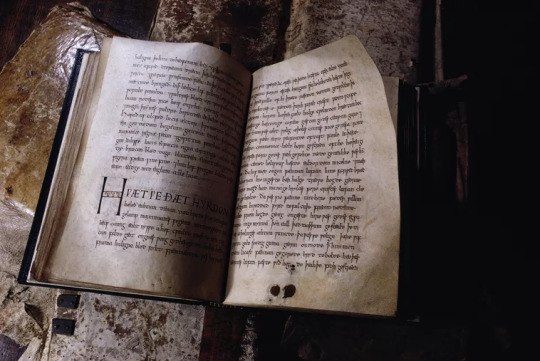
thoughtco.com
Old English, sometimes referred to as Anglo-Saxon, is the earliest historical form and the forefather of the contemporary English language. It was brought to Great Britain by Anglo-Saxon settlers probably in the mid-5th century and was spoken in England and Southern and Eastern Scotland in the early Middle Ages.
Why to learn?
Spoken in England before the Norman Conquest, Old English remains a truly Germanic language and shows the modern English connections to the Germanic family.
By learning Old English you can trace the evolution of a language over centuries on all levels from phonetic shifts to simplification of grammar and changes in vocabulary. This makes evident how a language responds to the changes in the society and how complicated grammar used to be.
Besides, it is written in the Anglo-Saxon variant of runes, so you can pretend to be a Viking.
Where to learn?
Old English Online is a course offered by the University of Texas where you will read through ancient texts building up your knowledge of Old English gradually.
Leornende Eald Englisc is a YouTube channel for those who likes less traditional and relaxed learning process.
Constructed Languages
Esperanto
Esperanto is the most successful international auxiliary language, with up to two million speakers. It was invented in the late 19th century by a Polish doctor, Ludwik Zamenhof, who wanted to end interethnic conflicts by providing everyone with a common and politically neutral tongue.
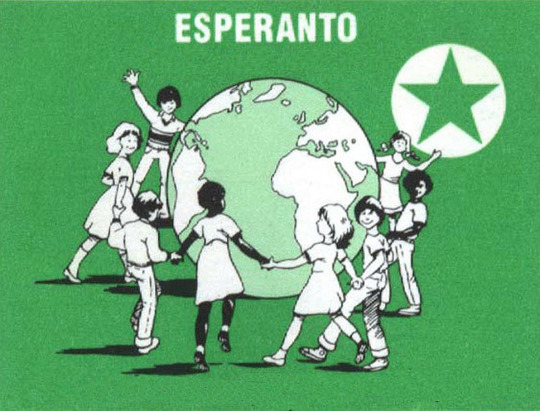
www.078.com.ua
Why to learn?
Contrary to old and dead languages, invented languages tend to simplify grammar and morphology. In Esperanto, word roots are mostly based on Latin and can be combined with affixes to form new words. The affixes can also stand alone: ejo = place, estro = leader/head, etc. The grammar has many traces of Slavic languages, although it is greatly simplified in comparison to them.
Spelling conventions are somewhat similar to Polish, though Zamenhof came up with some new letters for Esperanto (Ĉĉ, Ĝĝ, Ĥĥ, Ĵĵ, Ŝŝ, Ŭŭ). These letters are often replaced with ch, gh, jh or cx, gx, jx, or c’, g’, j’, etc.
Esperanto is an easy language to master with its small set of grammar rules and a transparent system of word endings: -o for nouns, -a for adjectives, -e for adverbs, -as for verbs in present tense. This makes grammar much clearer to a novice in language learning.
Where to learn?
Esperanto course– an app to learn basic Esperanto
Free Esperanto Course — a somewhat more traditional course explaining grammar rules and vocabulary.
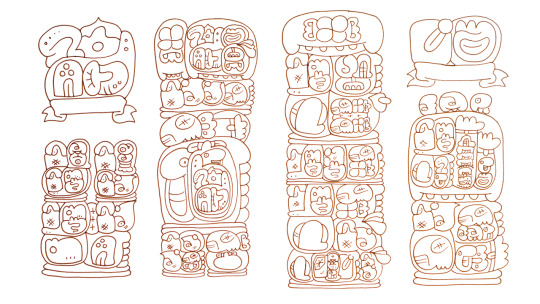
https://en.wikipedia.org/wiki/Toki_Pona#/media/File:Sitelen_sitelen_contract.jpg
Toki Pona
Toki Pona is a language created by the Canadian linguist and translator Sonja Lang as a philosophical language for the purpose of simplifying thoughts and communication.
Why to learn?
Lang designed Toki Pona to express maximal meaning with minimal complexity and to promote positive thinking. One of Toki Pona’s main goals is a focus on minimalism, as it focuses on simple concepts and universal elements. The language has 120–125 root words and 14 phonemes designed to be easy to pronounce for speakers of various language backgrounds. Therefore, learning this language can help switch the focus from complexity to the minimum repertoire.
Inspired by Taoist philosophy, the language is designed to help users remove complexity from the thought process. Even with the small vocabulary, speakers are able to communicate, mainly relying on context, which highlights the importance of non-linguistic means of communication.
Where to learn?
o kama sona e toki pona! — a Toki Pona course introducing grammar rules and vocabulary
speak toki pona — an introductory audio course
Klingon
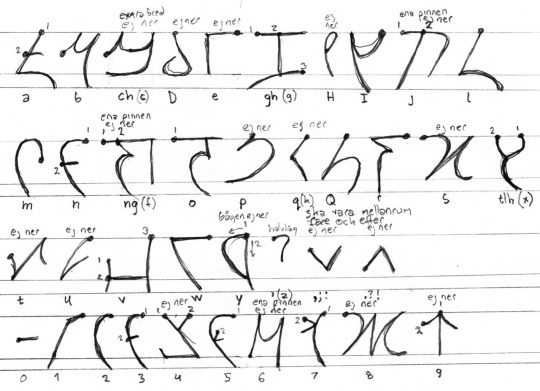
https://daily-klingon.tumblr.com/post/179493082615/this-is-the-piqad-script-as-developed-by-michael
Klingon, the language of a fictional warrior alien race in the Star Trek created by Marc Okrand and it is maybe the most famous constructed language.
Why to learn?
Perhaps the most fully realized science fiction language, Klingon has a complete grammar and vocabulary of 3000 words, so fans can actually learn it. There are even translations of Shakespeare, Sun Tzu and the Bible into the language.
Klingon was mostly created by a linguist who deliberately added complex rules and sounds that are rare in human languages. Therefore, this language, though not fully natural, can serve us as a proxy to understanding an alien — or at least a foreign — way of thinking and conceptualizing the world.
Another possible difficulty for anyone wanting to communicate in Klingon is that, as a space-based language, it’s lacking a lot of normal Earth words.

https://www.youtube.com/watch?v=K0cFLb-JmaQ Star Trek: Into Darkness
Where to learn?
There’s a Klingon Language Institute, the purpose of which is to promote the language and culture of this nonexistent people.
Learn Klingon the Easy(ish) Way — an online course of Klingon on You Tube
Learn Klingon Online — a complete course of Klingon
Quenya

https://en.wikipedia.org/wiki/Fictional_language
Quenya is one of the languages invented by JRR Tolkien in his Middle-earth world. A ceremonial Elvish tongue, it’s the most elaborate of all of Tolkien’s languages.
Why to learn?
First of all, Middle Earth was invented for Quenya and not vice versa: Tolkien began to write his stories in order to provide his language with a historical background. Tolkien tried to create the most beautiful language imaginable, and the sounds and grammar were taken mostly from the real Earth languages that he thought were the most beautiful: Finnish, Latin and Greek.
The most striking feature of Quenya is that it is a highly agglutinating language, meaning that multiple affixes are often added to words to express grammatical function. It is possible for one Quenya word to have the same meaning as an entire English sentence. Therefore, Quenya helps master a completely different way of building sentences and shows the possibilities of language economy.
It uses a special set of Elfish runes featuring, among others, representation of vowels with diacritics and the correspondence between shape features and sound features, and of the actual letter shapes.

https://www.looper.com/34326/things-you-didnt-know-about-the-ring-in-lord-of-the-rings/
Lord of the Rings (yes, we know that it’s the Black speech written in Tengwar)
Where to learn?
Quenya course — a textbook explaining Elfish grammar and introducing vocabulary.
Quenya — the Ancient Tongue — a brief survey providing the basics of Quenya grammar
High Valyrian
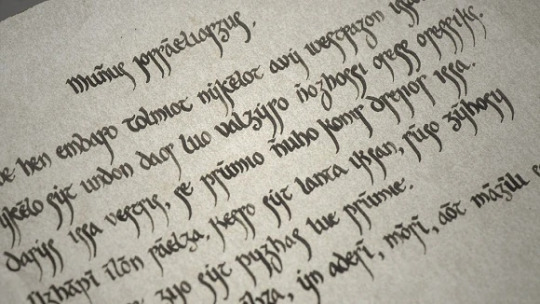
https://gameofthrones.fandom.com/wiki/High_Valyrian
High Valyrian is a ceremonial language from A Song of Ice and Fire series of fantasy novels by George R. R. Martin. While High Valyrian is not developed beyond a few words in the novels, for the TV series, linguist David J. Peterson created both the High Valyrian language, and its derivative languages Astapori and Meereenese Valyrian.
Why to learn?
This is the most recently developed language for the most popular TV series, so learning it at present is timely and trendy.
A dead language in the world of Westeros, High Valyrian occupies a cultural niche similar to that of Latin being the language of learning and education among the nobility, so learning it can make you feel double sophisticated (or nerd).
Despite its complicated inflectional grammar, High Valyrian does not have a special alphabet, so it is easier to master reading from the very beginning without additional obstacles.

https://gameofthrones.fandom.com/ru/wiki/%D0%9A%D1%80%D0%B0%D1%81%D0%BD%D1%8B%D0%B5_%D0%B6%D1%80%D0%B5%D1%86%D1%8B?file=%D0%9C%D0%B5%D0%BB%D0%B8%D1%81%D0%B0%D0%BD%D0%B4%D1%80%D0%B0_5x01.jpg
Where to learn?
High Valyrian Course — an app teaching the basic vocabulary and phrases
Learning High Valyrian — resources on grammar, phonology and vocabulary developed by fans
It might be that constructed languages lack the depth as they do not have actual system of idioms and metaphors behind them, or that dead languages are overcomplicated and outdated and no one would be able to communicate in them at present. However, learning such languages is an excellent exercise for our mind that help us develop more focus and attention and understand more about the logic of a language, the way we shape it and the way we want artificial languages — including machine ones — to work.
1 note
·
View note
Text
How Speech of Hindi Speaker Reflects Cultural Differences
My Aunty Krishna was born in New Delhi. She graduated from New Delhi with a degree in chemistry and a post-diploma in marketing. She grew up speaking Hindi and Punjabi. She has a distinct accent but awesome vocabulary and grammar. She goes in and out of Hindi and English when she talks to my parents. She talks to me in English but switches to Hindi when she gets excited, tells a funny story, makes fun of someone or something, or is trying to explain something quickly.
She came from a Hindu family and while she rejects Indian culture, she keeps the aspects that define the New Age movement. She married an American guy who follows Tibetan Buddhism so he is also part of the New Age Movement. So she had good help in learning American English instead of keeping the Indian British-English style of talking. It is interesting that the husband is European American but adopted a different set of values also, so they equally arrive in the middle of cultural exchange. She raised and socialized her kids totally American so it is clear that she values American culture more and which parts.
We visit each other’s houses a lot and we both talk too much so I easily disappear for 3 hours at a time. For another class I had to interview and record her, and the topic was about her values so my material about her cultural impressions helped two-fold.
She has strong high-context and collectivist habits but they are not applied rigidly or presumptuously like it’s the word of law like in India. Her word choices, social behavior, reasoning style, and belief system share common themes of balance, harmony, sharing, good will, giving back, holistic, inner peace, continuous introspection/self-education, and constant state of evolution.
The book said that Hindi speakers struggle being precise in English (209). Instead of straight shooting her point, she sounds like she is listing a bunch of examples. However, those examples will share an explicit common theme because they are exactly related to what the topic of the conversation is. So while it appears random, it is actually giving you additional useful information to continue that topic and discover insights for yourself. Here is a transcript for class:
How do you define this New Age movement that is popping up?
I love it! By trying to lessen my impact, my footprint. Trying to have voluntary simplicity, living in a small place, driving an efficient car, not caring about any labels. Because people are realizing that we are so dependent on things outside of us and we need to respect that. Well the main goal is to lower my carbon footprint. And ultimately be totally adaptable to voluntary simplicity. I am on the path but I am very far.
Her persuasion style is Analogical. Her idea’s start out sounding extremely random and everything somehow ties together at the last second (214). Her explanations take form of something that is easy to visualize so they sound like she is changing the subject. Actually, it combines thinking about different concepts at one time. This style makes sense for her because she comes from a “being” culture, which values the process of things rather than the finish line (86). So understanding the how and why part of the knowledge is emphasized rather than memorizing how the dots connect. I tried cutting down this quote but I also talk like this so I understand why every sentence was vital.
What elements of your philosophy come from India?
This is an interesting question you asked me! The belief in reincarnation, that is strengthened in Einstein’s equation; that mass and energy are inconvertible. That what happens to my consciousness when the material body in gone. Does the consciousness die? No, it gets converted, it is electromagnetic energy, my consciousness is electromagnetic energy that lives forever! Because energy cannot be destroyed, electromagnetic energy cannot be destroyed. And then Hinduism tells us that all souls are packets of electromagnetic energy, which put on different outfits. In one lifetime it could be an animal outfit and one time it can be a human outfit in order to evolve, in order to learn, in order to progress. So you keep taking birth and you keep getting a new set of parents… and the ultimate goal is to connect with the cosmic consciousness, to realize, the ultimate realization is, and its not logical it intuitive. You can’t think your way into it, it just is. To connect with the cosmic consciousness; that is the goal of reincarnation. To get to the stage to where you don’t feel separate from the cosmic consciousness, because that is where you originally came from the big bang ,right? Everything came from the big bang. And Hinduism very much teaches that. People think Hinduism is polytheistic, that so many gods and goddesses but that is actually not true. Everything goes to the original cosmic consciousness.
Another cultural pattern a noticed was in the Social Relations Orientation. Asia cultures need harmony in the group so openly saying “no” is uncomfortable (89). I noticed that she will avoid using the word, create a distraction around it, or make up an excuse so she can indirectly decline me (219). “I’m ok for now, thank you” or “I’m sorry honey, I’m feeling sick I can’t have more chai.” Maintaining everyone’s feelings is clearly highly valued by her because I’m 30 years younger than her and have known her for 5 years but she is still uncomfortable in declining even my simplest offerings like a cup of chai.
Her delicate interpersonal communication with me is a reflection of her collectivist cultural pattern. In the same style as the Chinese, friends are fully immersed into life (227). It feels like my house has acquired additional parents/siblings in the sense of their comfort in probing any part of my personal life or thought. She calls my parents “brother” and “sister” and I call her Aunty despite having no relation. “We-ness” takes place in the form of expectations that friends take care of each other’s kids as well (228). The friendship is expected to be continued through the kids. We are referenced to each other with “your sister.”
Her verbal codes, synactics, reflects her Hindi background. Hindi follows SOV form (158). Sometimes she will still place the conjugated verb at the end of the sentence like when she asked me “Well what do you think the voids are, it’s filling?” To show aggression, in English she says “you see this.” To be dramatic, in Hindi people will make up a rhyme word to attach to the end of the sentence or to the precise noun/verb/adjective they are belittling. She keeps this habit in English too. She hates technology so she says “I don’t understand this hi-fi nonsense” or “what is this love-shove, you are too young to have a boyfriend.” Her verbs and adjectives are never aggressive. “He shared with me” instead of “gave”, “it’s not my right” instead of “I won’t”, “give back” instead of “you have to.”
She continues Hindi’s pragmatic styles into English as well. Indian’s will show annoyance of someone by calling them “bhasiab” or “banji” (formal “brother” and “sister”). It looks respectful but it means you are getting stiff. When I come to her house she will offer chai and food multiple times but time and repetition will not stop her from bringing it to me (159). If she is frustrated with the conversation she will say the common Hindi phrase, which translates to “just die then”, sarcastically. It is not harsh, this is a common phrase that just shows that one is giving up on giving you the advice you really need to hear.
Her non-verbal codes lean towards Indian cultural patterns. She utilizes the same emblem that many Asian cultures use, wai (190). To show something does not add up or she does not understand, she will slightly twist her wrist with her fingers spread out and pointing up. Her affect displays mostly live through her eyes and hand gestures and mostly show enthusiasm. Her regulating behaviors are precisely Indian with me. High-context cultures have elaborate head nods and rockings, eyes, and eyebrows language (192). If I ask her a question, I have my answer just by seeing the manner in how she looks up to see me while nodding her head and coordinating her eyebrows. In Hindi and in English, she will punctuate a statement sentence with “no?” or “yes?” Voice tactics are highly consistent with Indian culture. She is easily excitable and loud, Punjabis are known for being more charismatic out of all Indians, and quickly recedes at a perceived slight. The rhythm and tone of certain words will be dragged out for dramatic affect, it is hard to explain but the way it is done explicitly shows the sentiment towards it (anger, passion, curiosity, etc).
Her speech reflects her World Orientation. Her purpose of her career was to serve her belief that humans are just a piece of nature and that it needs to be acknowledged (93). Here is part of my interview:
Why do you do what you do?
All life is valuable, not just human life. And we are all part of a circle, we are all connected and if you are indiscriminate and kill everything that is not human is upsetting the balance.
The book says that Indian people believe that they are subjugated to nature but they way this is worded is a little misleading because this “subjugation” is not seen as any form of insult or downgrade.
What is your response to/encounters with U.S anthropocentrism?
I don’t agree with that because even a rock has energy… it’s got a consciousness. Everything has a consciousness, we can’t tap into it, but that doesn’t mean its not there.
Even when she is sick, she describes it as a sign that she has been composing her life off track lately. Ailments are because of stress triggers. One time she had stomachaches for weeks but the source talk about was not it being bacterial (she does know that is the real reason though). The reason that the bacteria got to her was because she was so stressed about her daughters lately. She believes in science, but the motives for the biology changes in the body were psychologically self-inflected. So ill health is interpreted as a sign to slow down and introspect.
She is also Being Oriented. Everything she talked about was never said in a way that indicated it was finished. She describes everything as ‘being on the path, but still very far.’ She is in her 50’s, well educated, and always reading more, yet still is aware that she is never done learning or adjusting herself:
What are your experiences explaining your lifestyle to others?
Well first of all I have to explain my lifestyle to myself. I’m still at the stage where I am evolving, I want to have less cravings. I don’t have to explain my lifestyle to others. I have to explain it too myself! I have to come to terms with it myself, and what is lacking and what is it I would like more of.
She emphasizes how heart and intention is what contributes to the common good, not the right education or right lifestyle. Our conversations predominately discuss our failings. From an outsiders view, we sound like we cherish and praise them. The learning process is that sacred. We constantly dissect and decode the meanings in them and want feedback on it. This value is so sacred that is serves as a foundation for her work also:
What is the message you want people to receive from staying at your hotel?
To find the uniqueness inside themselves. Everybody has something, some unique attribute that they need to nurture in this lifetime.
This is unusual because in our culture mistakes are serious and are a shame or weakness. But not for us, she says that the process of getting the to ‘reward’ is the actually reward, because that is where the life lessons are, and it needs to be savored. Even while I was recording us, she told me to relax and have chai first because she could tell I was uncomfortable with recording our voices.
I would also say that this interview and my constant social interactions with her indicate that she values both intellectual and affective autonomy on Shwartz’s Taxonomy (113). I though it was interesting since the both did not mention any countries that valued both.
Examining her conversational style through this class helped me understand a lot about the way I think and talk. It was interesting to study her because Indians consider her Americanized yet according to this essay she sounds very Indian. Since everyone thinks we have the same behaviors and mannerisms, it means I turned out more Indian than I ever could have imagined.
This study showed that there is a stark boundary between what we believe is a good value for the culture to have and have a separate idea about what is a good personal value to have. We both overwhelming believe in American culture as a whole so we do not blend in with Indian people so much. Yet our social skills and mannerisms are very collectivistic. This study showed that simply knowing what is valued does not mean that the implications or manifestations will be easily translated to be predictable.
Sources
Lustig & Koester, 2013: Intercultural Competence; Interpersonal Communication Across Cultures
1 note
·
View note
Text
UP Police Recruitment 2019| Application Form Various Constable, Fireman, Bandi Rakshak Bharti Apply @ uppbpb.gov.in
UP Police Recruitment 2019
Hey guys, on this web page, a large chance of UP Government Job is available as UP Police Recruitment 2019 which is declared by Uttar Pradesh Police Department for Various vacancies. UP Police Jobs 2019 indeed is a huge chance for the aspirants who will wait to apply for the defense Jobs and secure their future, as UP Police gives chances to the job searchers in various departments with thousands of openings every year. Nowadays, Constable, Bandi Rakshak (Jail Warder), Fireman posts are vacant in Uttar Pradesh Police Department therefore interested and well-educated applicants are advised to apply for UP Police Vacancy 2019 by matching eligibility as below given. Job contenders should go to official website of Uttar Pradesh Police Department that is uppbpb.gov.in to make submission of the UP Police Online Application Form 2019. The Uttar Pradesh Police Department will start the application process from November 2019 and the entire process of Uttar Pradesh Police Vacancies 2019 will be completed in July 2019. Through, UP Police Recruitment 2018, Officials are planning to recruit the individuals for Constable, Bandi Rakshak (Jail Warder), Fireman Post to fill various Vacancies. Those aspirants who wish to catch this golden job opportunity in the Uttar Pradesh Police Department they must make submission of the UP Police Application Form 2019 shortly as possible in between the prescribed dates. The official website of the Uttar Pradesh Police Department from where excited job searchers will able to fill up the application form on or before the closing date that is given below.
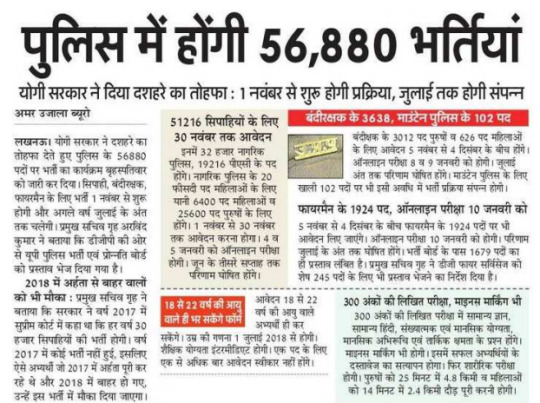
TNPSC AHO Recruitment 2018 AP DSC Notification 2018
uppbpb.gov.in Recruitment 2019 Brief Details:
Organization Name: Uttar Pradesh Police Department Posts Name: Constable, Bandi Rakshak (Jail Warder), Fireman, Mountain Police Posts Total: VariousVacancies Starting Date: Available Soon Last Date to Apply: Available Soon Official Website: uppolice.gov.in / uppbpb.gov.in Application Process: Online Mode OPSC ASO Recruitment 2019 CCL Apprentices Recruitment 2019 Bank of Baroda Professional Recruitment 2019 BRBNMPL Bank Recruitment 2019 UP Police Application Form 2019 Highlights: Vacancies Details: Constable – 51216 Vacancies Fireman – 1924 Vacancies Mountain Police – 102 Vacancies Bandi Rakshak – 3638 Vacancies Total – 56880 Vacancies Indian Army Religious Teacher Recruitment 2018 HSSC Group D Admit Card 2018 RSMSSB Recruitment 2018 Jiwaji University Recruitment 2018 Educational Qualification (शैक्षिक योग्यता): Applicants should have passed Intermediate from the recognized Board. English Improvement Best Tips Indian Bank Recruitment 2018 MRBTN Recruitment 2018 Delhi Shiksha Prasar Samiti Recruitment 2018 Age Limit (आयु सीमा): Minimum Age Limit: 18 Years Maximum Age Limit: 22 Years Salary Details: Selected aspirants will get a good amount of pay scale from the Uttar Pradesh Police Department. Applicants Fee: All category applicants need to pay Rs. 400/- through Debit Card, Credit Card, Net Banking before the last date. Selection Process: Selection of the aspirants will be done on the basis of their performance in Written Exam (Computer Based), Document Verification and Physical Standard Examination, Physical Efficiency Test and Final Merit List conducted by the organization. Physical Standard Test (PST): Gender Category Height Chest Male Gen/OBC/SC 168 cms 79-84 cms ST 160 cms 77-82 cms Female Gen/OBC/SC 152 cms N/A ST 147 cms N/A Interview Preparation Tips How to Prepare for Group Discussion LHMC Recruitment 2019 NPCIL Steno Recruitment 2019 How to Prepare For Exam Last Time Study UP Police Exam Pattern 2019: The UP Police written test will consist of total 300 marks. Candidates, there is 0.5 Mark will be deducted as a negative marking. UP Police Exam will be conducted in both Hindi and English language except General Hindi section. The written exam paper consists four sections - General Hindi, General Knowledge, Numerical & Mental Ability Test, Mental Aptitude Test/Intelligence Test/Test of Reasoning. Subject Questions Marks General Hindi 37 74 General Knowledge 38 76 Numerical & Mental Ability Test 38 76 Mental Aptitude Test/ Intelligence Test/Test of Reasoning 37 74 Total 150 300 UP Police Constable Syllabus 2019 – Syllabus for General Hindi – Hindi and regional language, Hindi grammar, Noun, Pronoun, Adjective, Tense, Verb, Idiom phrase, One word substitution, Reading comprehension, Famous poets, Award in Hindi language, Miscellaneous. Syllabus for General Knowledge – General Science, main focus on biology and health related programs, Indian Economy and Indian history, Freedom struggle of 1857, FDI and population survey, Indian geography and world geography, Relations with neighbouring countries, Law and administration of UP, Computer knowledge and Cyber act knowledge. Numerical & Mental Ability Test:- Syllabus for Numerical Aptitude – Number System, Simplification, Decimal & Fraction, HCF & LCM, Ratio & Proportion, Percentage, Profit & Loss, Discount, Simple Interest, Compound Interest, Partnership, Time & Work, Distance, Use of Table & Graph, Mensuration & Miscellaneous. Syllabus for Mental Ability Test – Logical Diagrams, Symbol-Relationship Interpretation, Codification, Perception Test, Word Formation Test, Letter and number series, Word and alphabet Analogy, Common Sense Test, Letter and number coding, Direction Sense Test, Logical interpretation of data, Forcefulness of argument, Determining implied meanings. Mental Aptitude Test/Intelligence Quotient Test/Test of Reasoning: Syllabus for Mental Aptitude Test – Public Interest, Law & Order, Communal Harmony, Crime Control, Rule of Law, Ability of Adaptability, Professional Information (Basic level), Police System, Contemporary Police Issues & Law and order, Basic Law, Interest in Profession, Mental Toughness, Sensitivity towards minorities and underprivileged & Gender sensitivity. Syllabus for Intelligence Quotient Test – Relationship and Analogy Test, Spotting out the dissimilar, Series Completion, Coding-Decoding, Direction Sense Test, Blood Relation, Problems based on alphabet, Time sequence test, Venn diagram and chart type test, Mathematical Ability Test, Arranging in order. Syllabus for Reasoning Test – Analogies, Similarities, Differences, Space visualization, Problem solving, Analysis and Judgment, Decision-making, Visual memory, Discrimination, Observation, Relationship, Concepts, Arithmetical Reasoning, Verbal and figure classification, Arithmetical number series, Abilities to deal with abstract ideas and symbols and their relationships, Arithmetical computations and other analytical functions. Way to Apply: Please check mention below steps before Apply: All interested candidates need to visit the official website of the organization which is “uppbpb.gov.in”. Press on the appropriate link on the home page. Download official notification and read it very carefully. Pthe ress on “Apply Online” link. Fill online application form with all required details. Upload all the required documents. Press on submit button & take a hard copy of filled online application form. .How To Fill Application Form UP Police Recruitment Important Dates: UP Police Bandi Rakshak & Mountain Police Notification Release Date Available Soon UP Police Bandi Rakshak Apply Online Start Date Available Soon UP Police Bandi Rakshak Application Form Last Date 4th December 2018 UP Bandi Rakshak & Mountain Police Exam Date 2019 8th and 9th January 2019 UP Police Fireman Exam Date 2019 10th January 2019 Bandi Rakshak, Fireman & Mountain Police Result 2019 Last Week of July 2018 UP Police Bandi Rakshak Official Notification 2018 Available Soon UP Police Mountain Police Official Notification 2018 Available Soon UP Police Fireman Official Notification 2018 Available Soon UP Police Application Form 2018-19 Available Soon UP Police Constable 2018-19 Apply Online Starting Date Available Soon UP Police Constable Application Form Last Date Available Soon UP Police Constable 2019 Admit Card Release Date Before 10 to 15 days of examination UP Police Constable 2019 Exam Date 4th and 5th January 2019 UP Police Constable 2019 Result Date 3rd week of June 2019 UP Police Constable Official Notification 2018-19 Available Soon UP Police Constable 2018 Apply Online Available Soon UP Police Recruitment Important Links: Download Official Notification in Hindi Apply Online Official Website All Government Jobs GPSC Recruitment 2018 BWSSB Recruitment 2018 SSC CPO Recruitment 2018 – 19 CCRT Recruitment 2018 Atul Maheshwari Scholarship Admit Card 2018 Hindustan Copper Limited Recruitment 2018 OPSC Dental Surgeon Recruitment 2018 SBI PO Admit Card 2018 RPSC Head Master Recruitment 2018 Gauhati HC Stenographer Recruitment 2018 Read the full article
0 notes
Text
New Post has been published on Add Crazy
New Post has been published on https://addcrazy.com/bureaucrat-by-way-of-day-ghaziabad-dm-turns-blogger-translator-at-night-time/
Bureaucrat by way of day, Ghaziabad DM turns blogger, translator at night time
Her first ‘severe’ translation is well-known author KR Meera’s bestseller, ‘Meera Sadhu,’ which turned into posted in Malayalam in 2008.
Ministry devoted nights to translate the e book into English, ‘The Poison of Love,’ posted via Hamish Hamilton (Penguin Random House India). The book now functions many of the long lists of 13 novels in rivalry to win the celebrated DSC Prize for South Asian Literature 2017.
Born with an affinity for literature, 2003 batch IAS officer, Ministry S, is now foraying into translating severe books, besides ably dedicating herself to the day-lengthy anxious agenda of bureaucrat example work.
Her first ‘extreme’ translation is famous author KR Meera’s bestseller, ‘Meera Sadhu,’ which changed into published in Malayalam in 2008. Ministry committed nights to translate the e book into English, ‘The Poison of Love,’ published by Hamish Hamilton (Penguin Random House India). The book now functions most of the long list of 13 novels in rivalry to win the celebrated DSC Prize for South Asian Literature 2017.
Ministry S has been a former special secretary (home) and is now serving as the district Justice of the Peace of Ghaziabad. However, she is a great deal extra than a bureaucrat in a sentence— she is a promising translator, transliterator, and a blogger sign in.
“I have been devoting time for translation, transliteration, and weblog writing throughout the past due night time hours. Earlier, I wrote several books, which includes a detective novel, however, stored it low-profile. However, translating books is some thing that I might name extreme paintings that I revel in,” Ministry stated, including that she has been blogging since 2014.She stated that KR Meera is one among her favorite writers and she bumped into her at a pal’s location in Lucknow in October 2015.
“I had written about ‘Meera Sadhu’ in my create your own blog. I asked Meera why nobody had translated the book into English. In reply, she instructed me to try it. The original novella runs for 50 pages. The first translated draft turned into out after one week and appreciated by means of the author and the publisher additionally gave his nod. With continued efforts, the e book becomes posted in February 2017. It feels amazing to be nominated for the prize,” Ministry introduced.
“Meera’s different books had been translated through literary folks however this time, she depended on a bureaucrat synonym,” she said. She stated that the story is certainly one of love, misplaced love, and love turning poisonous for revenge.
“Love is like milk. With the passage of time, it sours, splits and will become poison,” reads an excerpt from Meera’s e book.
“His touch became magical, spellbinding. It changed into as though I changed into in a trance. Like a ‘gopika’ enchanted with Krishna’s divine flute tune, I misplaced attention of the world around me. My body turned into underneath a few sort of black magic, I turned into thrown off stability…” reads some other excerpt.
Ministry holds an engineering diploma in electronics and conversation and went on to complete her MBA from XLRI, Jamshedpur. Her technical and management heritage coupled with bureaucratic paintings and her love for literary paintings makes her a multifaceted, particular man or woman.
She says that she finds her new ‘work’ to be enjoyable and sees it as a way of detaching from her grueling day by day habitual, which begins around five.30am and is going as much as 9 pm.
Ministry is currently translating a 215-page e book of KR Meera’s, except attempting her hand on English transliteration and interpretation of the ‘Sundarkanda’ – the 5th ‘sopan’ and one of the most famous chapters of ‘Ram Charitra Manas.’
“The poetry in the bankruptcy fascinated me. I wondered how people who do not recognize Hindi will understand the unique form. I completed this painting in nearly 50 days and the draft is in print,” she said.
The blog log in translation runs into 50 chapters Bureaucrat, including almost 156 pages, and is about to be published quickly in ghaziabad nagar nigam.
“My career and paintings as a translator merge seamlessly. I don’t think myself as ‘Ministhy’ or ‘district Justice of the Peace’ whilst translating throughout unfastened time. Initially, many mocked my translation work as I am not an expert author. I studied Hindi until class 10. I felt like a brand new actor struggling in Bollywood, however, rejections are part of lifestyles. The current translation work (‘The Poison of Love’) is a message to my critics,” she stated.
How to Write Like a Bureaucrat
Want to write with the maximum vague, difficult and unintelligible textual content you can come up with? Don’t worry, you do not want to be a legal professional, finance executive or in authorities to do it. Just observe the recommendations underneath and you’ll be properly in your way.
Don’t be polite. There’s nothing well mannered with the bureaucratic tone. Have you ever examine a contract that became well mannered? No. Exert your role of authority always and drop the pleasantries out of your vocabulary. Be direct when you’re rejecting a request. Say no with out an impunity. No one desires to understand your motives. If you offer them, they may mistake for diplomacy and take advantage of you. Just say no and be completely free of any clarification. Don’t suppose. No one wishes purpose in writing. Instead, appearance to coverage and precedence. Why compose a justification while you may really quote from the rulebook? Explanations are a sign of the weak spot. Never provide an explanation for. Just say what you want, no matter whether your reader is familiar with the motive in the back of it. Use passive verbs. They sound extra formal. Be aloof and remote. Never personalize a chunk of writing by the use of personal pronouns. Say phrases like “the company” or “the board of directors,” in no way “we.” When required to explain, start by way of attempting to provide an explanation for, then go off in tangents after the second one sentence. Why? Because explanations are a signal of the weak point. Also, use your grammar corrector to pick out more complex phrases than the ones you’ve got. The more obfuscated and unfamiliar, the better. Good good fortune.
farm house in ghaziabad- The Dark Horse of Real Estate Market
The developers are building several projects inside the city because the roads are being widened from NH24 that goes towards Ghaziabad. Numerous launches took place in the town and the numbers are increasing daily, as according to the reviews.
The city surely offers numerous assets classes whilst it comes to shopping for property. There are a plethora of options for the customers to choose from. There are plots, flats, multi-stage homes and plenty more for the consumers. There were many new launches of residences observed through plots within the metropolis which provided international-elegance facilities for the residents.
Property in best party place in ghaziabad is stated to have maximum launches in the cheap category. These structures occurred retaining in thoughts the center-class segment which should buy less expensive homes with primary facilities and world-class infrastructure. Almost, sixty-six% of the homes are beneath the less expensive segment inside the metropolis that is followed with the aid of the middle-segment and then the post segment.
In evaluation to all of NCR, Ghaziabad noticed the most of the recent elements with plush facilities. There have been numerous launches for plots and it constantly scores nicely over other varieties of property. Definitely, there are lots that buyers and consumers can take a look at this unique city.
Not only this, one can also put money into property in Ghaziabad to get right returns. Also, there are good rental assets in Ghaziabad that could really grasp the attention of buyers and investors to be able to place their houses son lease and get the good quantity for the equal.
There are diverse other factors that make the town a good alternative for funding in NCR. One primary purpose for the same is connectivity and easy accessibility of NCR from Ghaziabad. The region is strategically located and is surrounded by using Delhi, Faridabad, Noida, and Meerut. It has direct access to Delhi, Noida, and different regions within the metropolis at the side of the primary benefit of the dual carriageway. These genuinely makes it a capacity destination. Also, there are many new traits that are nevertheless underneath-production which could, in addition, increase the demands of property in Ghaziabad. The coming hyperlink road will further beautify the connectivity of Ghaziabad within the future. All these tendencies along side the approaching of many IT/ITES organizations led to increasing call for of residential and commercial assets in Ghaziabad with appropriate and profitable returns within the coming years.
Definitely, Ghaziabad has grown swiftly inside the beyond the couple of years which has expanded its call for no longer only by using the developers but via traders and shoppers as nicely.
https://addcrazy.com/
0 notes
Text
UP Police Recruitment 2019| Application Form Various Constable, Fireman, Bandi Rakshak Bharti Apply @ uppbpb.gov.in
UP Police Recruitment 2019
Hey guys, on this web page, a large chance of UP Government Job is available as UP Police Recruitment 2019 which is declared by Uttar Pradesh Police Department for Various vacancies. UP Police Jobs 2019 indeed is a huge chance for the aspirants who will wait to apply for the defense Jobs and secure their future, as UP Police gives chances to the job searchers in various departments with thousands of openings every year. Nowadays, Constable, Bandi Rakshak (Jail Warder), Fireman posts are vacant in Uttar Pradesh Police Department therefore interested and well-educated applicants are advised to apply for UP Police Vacancy 2019 by matching eligibility as below given. Job contenders should go to official website of Uttar Pradesh Police Department that is uppbpb.gov.in to make submission of the UP Police Online Application Form 2019. The Uttar Pradesh Police Department will start the application process from November 2019 and the entire process of Uttar Pradesh Police Vacancies 2019 will be completed in July 2019. Through, UP Police Recruitment 2018, Officials are planning to recruit the individuals for Constable, Bandi Rakshak (Jail Warder), Fireman Post to fill various Vacancies. Those aspirants who wish to catch this golden job opportunity in the Uttar Pradesh Police Department they must make submission of the UP Police Application Form 2019 shortly as possible in between the prescribed dates. The official website of the Uttar Pradesh Police Department from where excited job searchers will able to fill up the application form on or before the closing date that is given below.
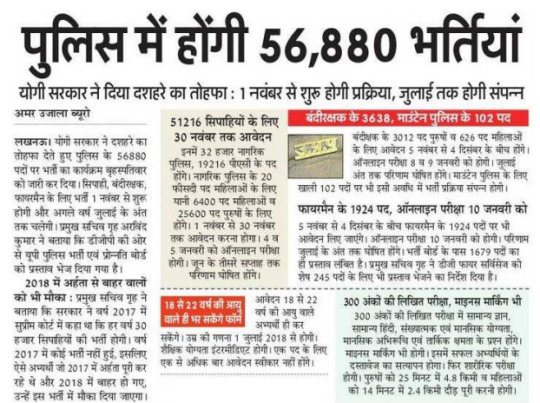
TNPSC AHO Recruitment 2018 AP DSC Notification 2018
uppbpb.gov.in Recruitment 2019 Brief Details:
Organization Name: Uttar Pradesh Police Department Posts Name: Constable, Bandi Rakshak (Jail Warder), Fireman, Mountain Police Posts Total: VariousVacancies Starting Date: Available Soon Last Date to Apply: Available Soon Official Website: uppolice.gov.in / uppbpb.gov.in Application Process: Online Mode OPSC ASO Recruitment 2019 CCL Apprentices Recruitment 2019 Bank of Baroda Professional Recruitment 2019 BRBNMPL Bank Recruitment 2019 UP Police Application Form 2019 Highlights: Vacancies Details: Constable – 51216 Vacancies Fireman – 1924 Vacancies Mountain Police – 102 Vacancies Bandi Rakshak – 3638 Vacancies Total – 56880 Vacancies Indian Army Religious Teacher Recruitment 2018 HSSC Group D Admit Card 2018 RSMSSB Recruitment 2018 Jiwaji University Recruitment 2018 Educational Qualification (शैक्षिक योग्यता): Applicants should have passed Intermediate from the recognized Board. English Improvement Best Tips Indian Bank Recruitment 2018 MRBTN Recruitment 2018 Delhi Shiksha Prasar Samiti Recruitment 2018 Age Limit (आयु सीमा): Minimum Age Limit: 18 Years Maximum Age Limit: 22 Years Salary Details: Selected aspirants will get a good amount of pay scale from the Uttar Pradesh Police Department. Applicants Fee: All category applicants need to pay Rs. 400/- through Debit Card, Credit Card, Net Banking before the last date. Selection Process: Selection of the aspirants will be done on the basis of their performance in Written Exam (Computer Based), Document Verification and Physical Standard Examination, Physical Efficiency Test and Final Merit List conducted by the organization. Physical Standard Test (PST): Gender Category Height Chest Male Gen/OBC/SC 168 cms 79-84 cms ST 160 cms 77-82 cms Female Gen/OBC/SC 152 cms N/A ST 147 cms N/A Interview Preparation Tips How to Prepare for Group Discussion LHMC Recruitment 2019 NPCIL Steno Recruitment 2019 How to Prepare For Exam Last Time Study UP Police Exam Pattern 2019: The UP Police written test will consist of total 300 marks. Candidates, there is 0.5 Mark will be deducted as a negative marking. UP Police Exam will be conducted in both Hindi and English language except General Hindi section. The written exam paper consists four sections - General Hindi, General Knowledge, Numerical & Mental Ability Test, Mental Aptitude oTest/Intelligence Test/Test of Reasoning. Subject Questions Marks General Hindi 37 74 General Knowledge 38 76 Numerical & Mental Ability Test 38 76 Mental Aptitude Test/ Intelligence Test/Test of Reasoning 37 74 Total 150 300 UP Police Constable Syllabus 2019 – Syllabus for General Hindi – Hindi and regional language, Hindi grammar, Noun, Pronoun, Adjective, Tense, Verb, Idiom phrase, One word substitution, Reading comprehension, Famous poets, Award in Hindi language, Miscellaneous. Syllabus for General Knowledge – General Science, main focus on biology and health related programs, Indian Economy and Indian history, Freedom struggle of 1857, FDI and population survey, Indian geography and world geography, Relations with neighbouring countries, Law and administration of UP, Computer knowledge and Cyber act knowledge. Numerical & Mental Ability Test:- Syllabus for Numerical Aptitude – Number System, Simplification, Decimal & Fraction, HCF & LCM, Ratio & Proportion, Percentage, Profit & Loss, Discount, Simple Interest, Compound Interest, Partnership, Time & Work, Distance, Use of Table & Graph, Mensuration & Miscellaneous. Syllabus for Mental Ability Test – Logical Diagrams, Symbol-Relationship Interpretation, Codification, Perception Test, Word Formation Test, Letter and number series, Word and alphabet Analogy, Common Sense Test, Letter and number coding, Direction Sense Test, Logical interpretation of data, Forcefulness of argument, Determining implied meanings. Mental Aptitude Test/Intelligence Quotient Test/Test of Reasoning: Syllabus for Mental Aptitude Test – Public Interest, Law & Order, Communal Harmony, Crime Control, Rule of Law, Ability of Adaptability, Professional Information (Basic level), Police System, Contemporary Police Issues & Law and order, Basic Law, Interest in Profession, Mental Toughness, Sensitivity towards minorities and underprivileged & Gender sensitivity. Syllabus for Intelligence Quotient Test – Relationship and Analogy Test, Spotting out the dissimilar, Series Completion, Coding-Decoding, Direction Sense Test, Blood Relation, Problems based on alphabet, Time sequence test, Venn diagram and chart type test, Mathematical Ability Test, Arranging in order. Syllabus for Reasoning Test – Analogies, Similarities, Differences, Space visualization, Problem solving, Analysis and Judgment, Decision-making, Visual memory, Discrimination, Observation, Relationship, Concepts, Arithmetical Reasoning, Verbal and figure classification, Arithmetical number series, Abilities to deal with abstract ideas and symbols and their relationships, Arithmetical computations and other analytical functions. Way to Apply: Please check mention below steps before Apply: All interested candidates need to visit the official website of the organization which is “uppbpb.gov.in”. Press on the appropriate link on the home page. Download official notification and read it very carefully. Pthe ress on “Apply Online” link. Fill online application form with all required details. Upload all the required documents. Press on submit button & take a hard copy of filled online application form. .How To Fill Application Form UP Police Recruitment Important Dates: UP Police Bandi Rakshak & Mountain Police Notification Release Date Available Soon UP Police Bandi Rakshak Apply Online Start Date Available Soon UP Police Bandi Rakshak Application Form Last Date 4th December 2018 UP Bandi Rakshak & Mountain Police Exam Date 2019 8th and 9th January 2019 UP Police Fireman Exam Date 2019 10th January 2019 Bandi Rakshak, Fireman & Mountain Police Result 2019 Last Week of July 2018 UP Police Bandi Rakshak Official Notification 2018 Available Soon UP Police Mountain Police Official Notification 2018 Available Soon UP Police Fireman Official Notification 2018 Available Soon UP Police Application Form 2018-19 Available Soon UP Police Constable 2018-19 Apply Online Starting Date Available Soon UP Police Constable Application Form Last Date Available Soon UP Police Constable 2019 Admit Card Release Date Before 10 to 15 days of examination UP Police Constable 2019 Exam Date 4th and 5th January 2019 UP Police Constable 2019 Result Date 3rd week of June 2019 UP Police Constable Official Notification 2018-19 Available Soon UP Police Constable 2018 Apply Online Available Soon UP Police Recruitment Important Links: Download Official Notification in Hindi Apply Online Official Website All Government Jobs GPSC Recruitment 2019 BWSSB Recruitment 2019 SSC CPO Recruitment 20119 CCRT Recruitment 2019 Atul Maheshwari Scholarship Admit Card 2019 Hindustan Copper Limited Recruitment 2019 OPSC Dental Surgeon Recruitment 2019 SBI PO Admit Card 2019 RPSC Head Master Recruitment 2018 Gauhati HC Stenographer Recruitment 2019 Read the full article
0 notes